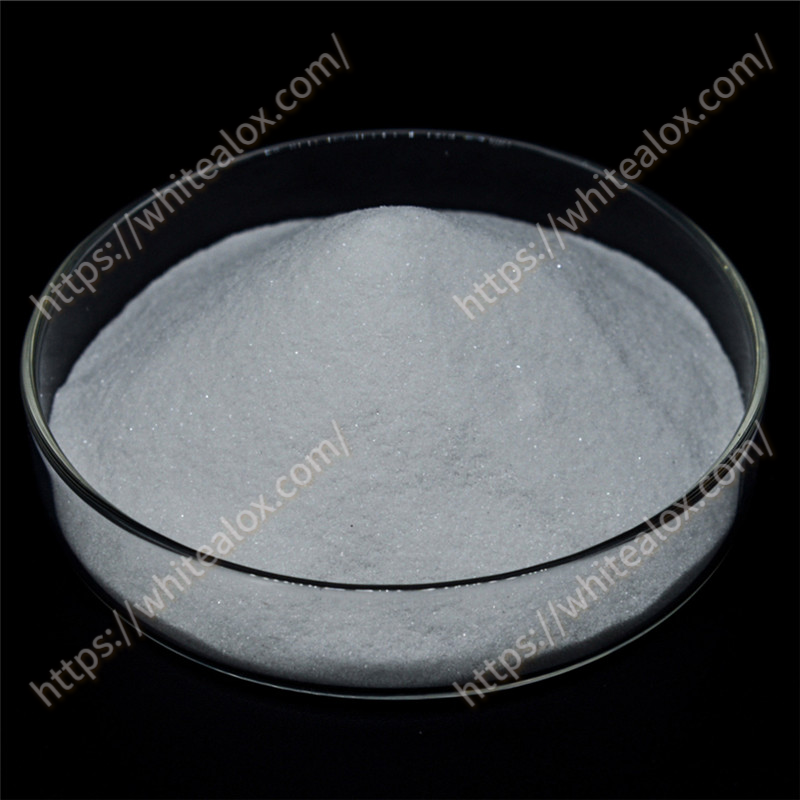White aluminum oxide is an artificial corundum material made from industrial alumina. It is a crystalline form of high-purity alumina (Al2O₃).
Composition and purity
The main component is aluminum oxide (Al2O₃), with a purity of more than 99% and very few impurities, so it has a white or light gray appearance.
Compared with ordinary brown corundum, white corundum has higher purity, better hardness and chemical stability.
Production process
Prepared by arc melting: industrial alumina is melted in a high-temperature furnace above 2000℃, and crystalline particles are formed after cooling, crushing and sorting.
Physical and chemical properties
| Typical Chemical composition | |
| AL2O3 | 99.3%min |
| SiO2 | 0.06% |
| Na2O | 0.3%max |
| Fe2O3 | 0.05%max |
| CaO | 0.04%max |
| MgO | 0.01%max |
| K2O | 0.02#max |
| Typical physical properties | |
| Hardness: | Mohs:9.0 |
| Maximum service temperature: | 1900 ℃ |
| Melting Point: | 2250 ℃ |
| Specific Gravity: | 3.95g/cm3 |
| Volume density | 3.6g/cm3 |
| Bulk density(LPD): | 1.75-1.95 g/cm3 |
| Color: | White |
| Particle shape: | Angular |
| Available size: | |
| F8# F10# F12# F14# F16# F20# F22# F24# F30# F36# F46# F54# F60# F70# F80# F90# F100# F120# F150# F180# F220# | |
| Grit | 1 | 2 | 3 | 3 and 4 | 5 | Q5(≤) | ||||
| W1 (um) | Q1 | W2(um) | Q2(≤) | W3(um) | Q3(≥) | W4(um) | Q3+Q(≥) | W5(um) | ||
| F8 | 4000 | 0 | 2800 | 20% | 2360 | 45% | 2000 | 70% | 1700 | 3% |
| F10 | 3350 | 0 | 2360 | 20% | 2000 | 45% | 1700 | 70% | 1400 | 3% |
| F12 | 2800 | 0 | 2000 | 20% | 1700 | 45% | 1400 | 70% | 1180 | 3% |
| F14 | 2360 | 0 | 1700 | 20% | 1400 | 45% | 1180 | 70% | 1000 | 3% |
| F16 | 2000 | 0 | 1400 | 20% | 1180 | 45% | 1000 | 70% | 850 | 3% |
| F20 | 1700 | 0 | 1180 | 20% | 1000 | 45% | 850 | 65% | 710 | 3% |
| F24 | 1180 | 0 | 850 | 25% | 710 | 45% | 600 | 65% | 500 | 3% |
| F30 | 1000 | 0 | 710 | 25% | 600 | 45% | 500 | 65% | 425 | 3% |
| F36 | 850 | 0 | 600 | 25% | 500 | 45% | 425 | 65% | 355 | 3% |
| F40 | 710 | 0 | 500 | 30% | 425 | 40% | 355 | 65% | 300 | 3% |
| F46 | 600 | 0 | 425 | 30% | 355 | 40% | 300 | 65% | 250 | 3% |
| F54 | 500 | 0 | 355 | 30% | 300 | 40% | 250 | 65% | 212 | 3% |
| F60 | 425 | 0 | 300 | 30% | 250 | 40% | 212 | 65% | 180 | 3% |
| F70 | 355 | 0 | 250 | 25% | 212 | 40% | 180 | 65% | 150 | 3% |
| F80 | 300 | 0 | 212 | 25% | 180 | 40% | 150 | 65% | 125 | 3% |
| F90 | 250 | 0 | 180 | 20% | 150 | 40% | 125 | 65% | 106 | 3% |
| F100 | 212 | 0 | 150 | 20% | 125 | 40% | 106 | 65% | 90 | 3% |
| F120 | 180 | 0 | 125 | 20% | 106 | 40% | 90 | 65% | 75 | 3% |
| F150 | 150 | 0 | 106 | 15% | 90 | 40% | 75 | 65% | 63 | 3% |
| F180 | 125 | 0 | 90 | 15% | 75 | * | 63 | 40% | 53 | * |
| F220 | 106 | 0 | 75 | 15% | 63 | * | 53 | 40% | 45 | * |
Extremely high hardness: Mohs hardness is 9, with excellent wear resistance and cutting performance.
High temperature resistance: melting point is about 2050℃
Chemical inertness: acid and alkali corrosion resistance, good insulation performance.
Application:
Abrasives: used to manufacture precision machining tools such as grinding wheels and grinding pastes.
Refractory materials: used for high-temperature kiln linings, refractory castables, etc.
Industrial parts: such as precision instrument coatings, semiconductor material processing.
The advantages of white fused alumina as a sandblasting material are mainly reflected in the following aspects:
1. High hardness and wear resistance
The Mohs hardness is 9, with strong cutting force, and can quickly remove impurities on the surface of the workpiece .
Excellent wear resistance, service life is 3-5 times that of ordinary sandblasting materials.
2. High purity and cleanliness
The aluminum oxide content is ≥99%, with very few impurities, and there is no residual pollution on the surface of the workpiece
3. Uniform particle shape
The crystal structure is dense, the particles are multi-angular and evenly distributed, and the surface roughness is consistent after sandblasting, which is conducive to the adhesion of subsequent coating, electroplating and other processes.
4. Strong chemical stability
Acid and alkali resistant, not easy to react in humid or chemical environments, avoiding secondary corrosion of workpieces.
5. Environmental protection and economy
Can be recycled 5-8 times, with low loss rate, reducing waste emissions.

